User:Векочел/List of Roman emperors
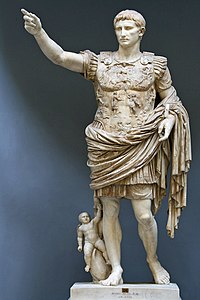
The Roman emperors were rulers of the Roman Empire, wielding power over its citizens and military, dating from the granting of the title of Augustus to Gaius Julius Caesar Octavianus by the Roman Senate in 27 BC. Augustus maintained a façade of republican rule, rejecting monarchical titles but calling himself princeps senatus (first man of the senate)[1] and princeps civitatis (first citizen of the state). The title of Augustus was conferred on his successors to the imperial position. The style of government instituted by Augustus is called the Principate and continued until reforms by Diocletian. The modern word 'emperor' derives from the title imperator, which was granted by an army to a successful general; during the initial phase of the empire, it still had to be earned by the princeps.
The territory under command of the emperor had developed under the period of the Roman Republic as it invaded and occupied most of Europe and portions of northern Africa and western Asia. Under the republic, regions of the empire were ruled by provincial governors answerable to and authorised by the Senate and People of Rome. During the republic, the chief magistrates of Rome were two consuls elected each year; consuls continued to be elected in the imperial period, but their authority was subservient to that of the emperor, and the election was controlled by the emperor.
In the late 3rd century, after the Crisis of the Third Century, Diocletian formalised and embellished the recent manner of imperial rule, establishing the so-called Dominate period of the Roman Empire. This was characterised by the explicit increase of authority in the person of the Emperor, and the use of the style Dominus Noster ("Our Lord"). The rise of powerful Barbarian tribes along the borders of the empire and the challenge they posed to defense of far-flung borders and unstable imperial succession led Diocletian to divide the administration geographically of the Empire in 286 with a co-Augustus. In 330, Constantine the Great established a second capital in Byzantium, which he renamed Constantinople. For most of the period from 286 to 480, there was more than one recognised senior emperor, with the division usually based in geographic terms. This division was consistently in place after the death of Theodosius I in 395, which historians have dated as the division between the Western Roman Empire and the Eastern Roman Empire.[2] However, formally the Empire remained a single polity, with separate co-emperors in the separate courts. The fall of the Western Roman Empire, and so the end of a separate list of emperors below, is dated either from the de facto date of 476 when Romulus Augustulus was deposed by Odoacer who became King of Italy, or the de jure date of 480, on the death of Julius Nepos, when Eastern Emperor Zeno ended recognition of a separate Western court. In the period that followed, the Empire is usually treated by historians as the Byzantine Empire governed by the Byzantine Emperors, although this designation is not used universally, and continues to be a subject of specialist debate today.[3]
The line of emperors continued until the death of Constantine XI Palaiologos during the fall of Constantinople in 1453, when the remaining territories were captured by the Ottoman Empire.[4]
Legitimacy
[edit]The emperors listed in this article are those generally agreed to have been "legitimate" emperors, and who appear in published regnal lists.[5][6][7] The word "legitimate" is used by most authors, but usually without clear definition, perhaps not surprisingly, since the emperorship was itself rather vaguely defined legally. In Augustus' original formulation, the princeps was selected by either the Senate or "the people" of Rome, but quite quickly the legions became an acknowledged stand-in for "the people." A person could be proclaimed as emperor by their troops or by "the mob" in the street, but in theory needed to be confirmed by the Senate. The coercion that frequently resulted was implied in this formulation. Furthermore, a sitting emperor was empowered to name a successor and take him on as apprentice in government and in that case the Senate had no role to play, although it sometimes did when a successor lacked the power to inhibit bids by rival claimants. By the medieval (or Byzantine) period, the very definition of the Senate became vague as well, adding to the complication.[8]
Principate
[edit]27 BC–68 AD: Julio-Claudian dynasty
[edit]| No. [note 1] |
Portrait | Regnal name[note 2] | Notes | Reign start | Reign end | Time in office | Sources |
|---|---|---|---|---|---|---|---|
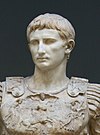
|
Imp(erator) Caesar Divi F(ilivs) Avgvstvs (63 BC–14 AD) |
Great-nephew and adopted son of Julius Caesar; became de facto emperor as a result of the 'first settlement' between himself and the Roman Senate. | 16 January 27 BC | 19 August 14 AD | 40 years, 7 months and 3 days | [9][10][11][12] | |

|
Ti(berivs) Caesar Divi Avg(vsti) F(ilivs) Avgvstvs (42 BC–37 AD) |
Natural son of Livia Drusilla, Augustus' third wife, by a previous marriage. Married in turn Vipsania Agrippina, the daughter of Marcus Vipsanius Agrippa, then Augustus' daughter Julia the Elder, who had been widowed twice (her second marriage was to Agrippa). He was adopted by Augustus as his son and heir. He may have been assassinated by the praetorian prefect Naevius Sutorius Macro or by Caligula. | 17 or 18 September 14[note 3] | 16 March 37 | 22 years, 5 months and 27 days | [13][14][15][16] | |

|
Caligula C(aius) Caesar Avg(vstvs) Germ(anicvs)[note 4] (12–41) |
Son of Germanicus, the nephew and adopted son of Tiberius, and Agrippina the Elder, daughter of Marcus Vipsanius Agrippa and Julia the Elder. Assassinated in a conspiracy led by Cassius Chaerea. | 16 March 37 | 24 January 41 | 3 years, 10 months and 8 days | [17][18][19] | |

|
Ti(berivs) Claud(ivs) Caesar Avg(vstvs) Germ(anicvs) (10 BC–54 AD) |
Brother of Germanicus; great-nephew and step-grandson of Augustus; proclaimed emperor by a Roman soldier following the assassination of his nephew Caligula. He was supposedly poisoned by his wife Agrippina the Younger, in favour of her son Nero. | 24 January 41 | 13 October 54 | 13 years, 8 months and 20 days | [20][21][22][23] | |
| [24][25] | |||||||
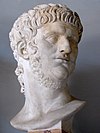
|
Nero Clavdivs Caesar Avgvstvs Germanicvs (37–68) |
Son of Agrippina the Younger, who was the daughter of Germanicus, sister of Caligula, and wife of her own uncle Claudius. Nero became the heir of his stepfather Claudius, sidelining the emperor's own son Britannicus, and married Claudius' daughter Claudia Octavia. Abandoned by the Senate and the Praetorian Guard, he committed suicide. | 13 October 54 | 9 June 68 | 13 years, 7 months and 27 days |
68–96: Year of the Four Emperors and Flavian dynasty
[edit]| No. | Portrait | Regnal name | Notes | Reign start | Reign end | Time in office | Sources |
|---|---|---|---|---|---|---|---|

|
Imp(erator) Ser(vivs) Galba Caesar Avg(vstvs) (3 BC–69 AD) |
Seized power after Nero's suicide, with support of Spanish Legions. Murdered by Praetorian Guard in coup led by Otho. | 9 June 68 | 15 January 69 | 7 months and 7 days | [26][27] | |
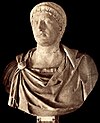
|
Imp(erator) M(arcus) Otho Caesar Avg(vstvs) (32–69) |
Appointed by Praetorian Guard. Committed suicide after his defeat by Vitellius. | 15 January 69 | 16 April 69 | 3 months and 1 day | [28][29] | |
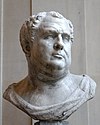
|
A(vlvs) Vitellivs Germ(anicvs) Imp(erator) Avg(vstvs) (15–69) |
Seized power with support of German Legions (in opposition to Galba/Otho). Murdered by his own troops. | 17 April 69[note 5] | 20 December 69 | 8 months and 3 days | [30][31][32][33] | |
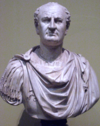
|
Imp(erator) Caesar Vespasianvs Avg(vstvs) (9–79) |
Seized power with the support of Egyptian Legions. | 21 December 69[note 6] | 24 June 79 | 9 years, 6 months and 3 days | [33][34] | |

|
Imp(erator) Titvs Caes(ar) Vespasian(vs) Avg(vstvs) (39–81 |
Son of Vespasian. | 24 June 79 | 13 September 81 | 2 years, 2 months and 20 days | [33][35][36] | |

|
Imp(erator) Caes(ar) Domit(ianvs) Avg(vstvs) Germ(anicvs) (51–96) |
Son of Vespasian. Domitian was assassinated by praetorian prefects and officials of the palace. | 14 September 81 | 18 September 96 | 15 years and 4 days | [36][37][38] |
96–192: Nerva-Antonine dynasty
[edit]| No. | Portrait | Regnal name | Notes | Reign start | Reign end | Time in office | Sources |
|---|---|---|---|---|---|---|---|

|
Imperator Nerva Germanicvs Caesar Avgvstvs (30–98) |
Became emperor after the assassination of Domitian | 18 September 96 | 27 January 98 | 1 year, 4 months and 9 days | [39] | |

|
Imperator Caesar Nerva Traianvs Avgvstvs (53–117) |
Adopted son and heir of Nerva | 28 January 98 | 7 August 117 | 19 years, 6 months and 10 days | [40] | |

|
Imp(erator) Caesar Traian(vs) Hadrianvs Avg(vstvs) (76–138) |
Succeeded Trajan with the help of Trajan's widow Pompeia Plotina | 11 August 117 | 10 July 138 | 20 years, 10 months and 30 days | [41][42] | |

|
Imp(erator) T(itus) Ael(ivs) Caes(ar) Hadr(ianvs) Antoninvs Avg(vstvs) Pivs (86–161) |
Adopted son and heir of Hadrian | 10 July 138 | 7 March 161 | 22 years, 6 months and 28 days | [43][44] | |

|
Imperator Caesar Lvcivs Avrelivs Vervs (130–169) |
Adopted son of Antoninus Pius and son-in-law of Marcus Aurelius; Co-emperor with Marcus Aurelius | 7 March 161 | January 169 | 7 years, 10 months | [45][46] | |

|
Imperator Caesar Marcvs Aurelivs Antoninvs Avgvstvs (121–180) |
Adopted son and son-in-law of Antoninus Pius; Co-emperor with Lucius Verus until 169 | 17 March 180 | 19 years and 10 days | |||

|
Imp(erator) L(vcivs) Avrel(ivs) Commodvs Avg(vstvs) (161–192) |
Natural son of Marcus Aurelius; joint emperor from 177 | 177 | 3 years | [46][47][48] | ||
| Imp(erator) M(arcvs) Commodvs Antoninvs Avg(vstvs) (180 to 183)
Imp(erator) M(arcvs) Commodvs Anton(invs) Avg(vstvs) Pivs (183 to 185) Imp(erator) M(arcvs) Comm(odvs) Ant(oninvs) P(ivs) Fel(ix) Avg(vstvs) (185 to 192) Imp(erator) L(vcivs) Ael(ivs) Avrel(ivs) Comm(odvs) Avg(vstvs) P(ivs) Fel(ix) (192) |
Sole emperor from 180; assassinated in palace, strangled in his bath | 17 March 180[note 7] | 31 December 192 | 12 years, 9 months and 14 days |
193–235: Year of the Five Emperors and Severan dynasty
[edit]| No. | Portrait | Regnal name | Notes | Reign start | Reign end | Time in office | Sources |
|---|---|---|---|---|---|---|---|

|
Imp(erator) Caes(ar) P(vblivs) Helv(ivs) Pertin(ax) Avg(vstvs) (126–193) |
Proclaimed emperor by Praetorian Guard. Murdered by Praetorian Guard. | 1 January 193 | 28 March 193 | 2 months and 27 days | [49][50][51] | |

|
Imp(erator) Caes(ar) M(arcvs) Did(ivs) Ivlian(vs) Avg(vstvs) (133–193) |
Won auction held by the Praetorian Guard for the position of emperor. Executed on orders of the Senate. | 28 March 193 | 1 June 193 | 2 months and 4 days | [51][52][53] | |

|
Imp(erator) Cae(sar) L(vcivs) Sep(timivs) Sev(ervs) Pert(inax) Avg(vstvs) (145/146–211) |
Seized power with support of Pannonian legions.[note 8] | June 193[note 9] | 4 February 211 | 17 years, 9 months and 26 days | [53][54][55][56] | |
| Caracalla Imp(erator) C(aesar) M(arcvs) Avr(elivs) Antoninvs Avg(vstvs) (188–217) |
Elder son of Septimius Severus; co-emperor with Severus and Geta. | 198 | 13 years | [57][58][59][60] | |||

|
Imp(erator) Caes(ar) P(vblivs) Sept(imivs) Geta Pivs Avg(vstvs) (189–211) |
Younger son of Septimius Severus; co-emperor with Severus and Caracalla. | 209 | 2 years | |||
| Co-ruler with his brother Caracalla. Murdered on the orders of Caracalla. | 4 February 211 | 26 December 211 | 10 months and 22 days | ||||

|
Caracalla Imp(erator) C(aesar) M(arcvs) Avr(elivs) Antoninvs Avg(vstvs) (188–217) |
Co-ruler with his brother Geta. | |||||
| Sole emperor. Assassinated. | 26 December 211 | 8 April 217 | 5 years, 3 months and 13 days | ||||
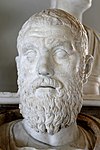
|
Imp(erator) C(aesar) M(arcvs) Opel(livs) Sev(ervs) Macrinvs Avg(vstvs) (164/165–218) |
Praetorian Prefect to Caracalla, probably conspired to have Caracalla murdered. Proclaimed himself emperor after Caracalla's death. | 11 April 217 | 8 June 218 | 1 year, 1 month and 28 days | [61][62][63] | |

|
M(arcvs) Opel(livs) Ant(oninvs) Diadvmenian(vs) Caes(ar) Avgvstvs (208–218) |
Son of Macrinus. Proclaimed co-emperor by his father. Both Macrinus and Diadumenian were executed in favour of Elagabalus. | May 218 | 1 month | |||
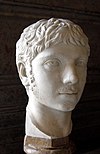
|
Elagabalus Imp(erator) Caes(ar) M(arcvs) Avr(elivs) Antoninvs Avg(vstvs) (203–222) |
Grandson of Julia Maesa, the sister-in-law of Septimius Severus. Following the death of his cousin Caracalla, he was proclaimed emperor by the Syrian legions. Murdered by Praetorian Guard. | 8 June 218 | 11 March 222 | 3 years, 9 months and 3 days | [64][65][66] | |
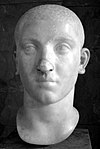
|
Imp(erator) C(aesar) M(arcvs) Avr(elivs) Sev(ervs) Alexand(er) Avg(vstvs) (207–235) |
Grandson of Julia Maesa. Cousin and adoptive heir of Elagabalus. Murdered by the army. | 13 March 222 | 18 March 235 | 13 years and 5 days | [67][68][69] |
235–285: Gordian dynasty and Crisis of the Third Century
[edit]| No. | Portrait | Regnal name | Notes | Reign start | Reign end | Time in office | Sources |
|---|---|---|---|---|---|---|---|
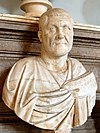
|
Imp(erator) Maximinvs Pivs Avg(vstvs) (173–238) |
Proclaimed emperor by German legions after the murder of Severus Alexander. Assassinated by his troops. | 19 March 235 | May/June 238 | 3 years, 3 months | [70][71] | |

|
Imperator Caesar Marcvs Antoninvs Gordianvs (I) Sempronianvs Romanvs Africanvs Avgvstvs (157/159–238) |
Proclaimed emperor while Pro-consul in Africa during a revolt against Maximinus. Ruled jointly with his son Gordian II and in opposition to Maximinus. Committed suicide upon hearing of the death of Gordian II. | January 238[note 10] | ~3 weeks | [73][74] | ||

|
Imperator Caesar Marcvs Antoninvs Gordianvs (II) Sempronianvs Romanvs Africanvs Avgvstvs (192–238) |
Proclaimed emperor alongside his father in opposition to Maximinus. Killed in battle. | |||||
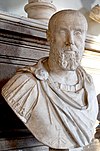
|
Imperator Caesar Marcvs Clodivs Pvpienvs Maximvs Avgvstvs (c. 164–238)[75] |
Proclaimed joint emperor with Balbinus by the Senate after death of Gordian I and II in opposition to Maximinus; co-emperor with Balbinus. Assassinatedby Praetorian Guard. | February 238[note 10] | May 238[note 10] | 3 months and 7 days | [75][76][77] | |

|
Imp(erator) C(aesar) D(ecimvs) Cael(ivs) Balbinvs Avgvstvs (died 238)[note 11] |
Appointed joint emperor by a Senate committee, of which he himself was a member, with Pupienus; co-emperor with Pupienus. Assassinated by Praetorian Guard. | |||||
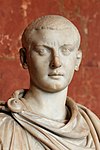
|
Imperator Caesar Marcvs Antonivs Gordianvs (III) Pivs Felix Avgvstvs (225–244) |
Grandson and nephew of Gordian I and II, respectively. Proclaimed emperor by the Praetorian Guard upon the assassination of Pupienus and Balbinus. | 9 May 238[note 10] | c. February 244 | 5 years, 9 months | [78][79] | |

|
Imp(erator) C(aesar) M(arcvs) Ivl(ivs) Philippvs Avg(vstvs) (c. 204–249) |
Praetorian Prefect, took power after the death of Gordian III. Killed by his soldiers after his defeat by Decius. | February 244 | September 249 | 5 years | [80][81][82][83] | |

|
Aὐτόκ(ράτ) K(αίσαρας) M(άρκος) I(ούλιος) Φιμιππος (Β΄) Ϲεβ(αστός) Imperator C(aesar) M(arcvs) I(vlivs) Philippvs (II) Avgvstvs (238–249) |
Son of Philip the Arab, proclaimed co-emperor by his father. Murdered by the Praetorian Guard after the death of his father. | July/August 247 | 2 years | |||
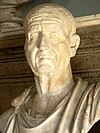
|
Imp(erator) C(aesar) M(essivs) Q(vintvs) Traianvs Decivs Avg(vstvs) (201–251) |
General on the Danube under Philip the Arab; proclaimed emperor by Danubian legions then defeated and killed Philip in battle. | September 249 | June 251 | 2 years | [84][85][86][87][88][89][90] | |

|
Imp(erator) C(aesar) Q(vintvs) Her(ennivs) Etr(vscvs) Mes(sivs) Deci(vs) Avg(vstvs) (227–251) |
Son of Decius; proclaimed co-emperor by his father. Both he and his father were killed in the Battle of Abrittus fighting against the Goths. | early 251 | A few months | |||

|
Imperator Caesar Caivs Valens Hostilianvs Messivs Qvintvs Avgvstvs (c. 230–251) |
Son of Decius, accepted as heir by the Senate | June 251 | c. 251 | A few months | ||

|
Imperator Caesar Gaivs Vibivs Afinivs Trebonianvs Gallvs Avgvstvs (206–253) |
Governor of Moesia Superior, proclaimed emperor by Danubian legions after Decius' death. | August 253 | 2 years | |||

|
Imperator Caesar Gaivs Vibivs Volvsianvs Avgvstvs (died 253) |
Proclaimed co-emperor by his father Trebonianus Gallus. Gallus and Volusianus were assassinated by their own troops in favour of Aemilian. | late 251 | ||||
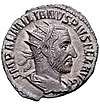
|
Imperator Caesar Marcvs Aemilivs Aemilianvs Avgvstvs (207/213–253) |
Governor of Moesia Superior, proclaimed emperor by Danubian legions after defeating the Goths; accepted as emperor after death of Gallus. Assassinated by his own troops in favour of Valerian. | August 253 | October 253 | 2 months | ||
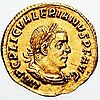
|
Imperator Caesar Pvblivs Licinivs Valerianvs Avgvstvs (195–after 260) |
Governor of Noricum and Raetia, proclaimed emperor by Rhine legions after death of Gallus; accepted as emperor after death of Aemilian. Captured in Battle of Edessa against Persians, died in captivity. | October 253 | 260 | <7 years | ||

|
Imperator Caesar Pvblivs Licinivs Egnativs Gallienvs Avgvstvs (218–268) |
Son of Valerian, made co-emperor in 253. | July 260 | 6 years, 9 months | |||

|
Imperator Caesar Cornelivs Licinivs Saloninvs Valerianvs Pivs Felix Invictvs Avgvstvs (242–260) |
Son of Gallenius, made co-emperor. Assassinated by Postumus. | July 260 | Very brief (less than a month) | |||

|
Imperator Caesar Pvblivs Licinivs Egnativs Gallienvs Avgvstvs (218–268) |
Sole emperor. Murdered at Aquileia by his own commanders. | July 260 | September 268 | 8 years, 2 months | ||

|
Imperator Caesar Marcvs Avrelivs Valerivs Clavdivs Avgvstvs (214–270) |
Victorious general at Battle of Naissus, seized power after Gallienus's death | September 268 | January 270 | 1 year, 4 months | ||

|
Imperator Caesar Marcvs Avrelivs Clavdivs Qvintillvs Avgvstvs (210–270) |
Brother of Claudius II, seized power after his death. Circumstances of his death are unclear, possibly suicide or murder. | January 270 | September(?) 270 | ~8 months | ||

|
Imperator Caesar Lvcivs Domitivs Avrelianvs Avgvstvs (214/215–275) |
Proclaimed emperor by Danubian legions after Claudius II's death, in opposition to Quintillus. Assassinated by Praetorian Guard. | September(?) 270 | September 275 | 5 years | ||

|
Imperator Caesar Marcvs Clavdivs Tacitvs Avgvstvs (200–276) |
Elected by the Senate to replace Aurelian after a short interregnum. Believed to have died of natural causes, possibly assassinated. | 25 September 275 | June 276 | 9 months | ||

|
Imperator Caesar Marcvs Annivs Florianvs Avgvstvs (died 276) |
Brother of Tacitus, elected by the army in the west to replace him. Assassinated by his own troops in favour of Probus | June 276 | September(?) 276 | 3 months | ||

|
Imperator Caesar Marcvs Avrelivs Probvs Avgvstvs (232–282) |
Governor of the eastern provinces, proclaimed emperor by Danubian legions in opposition to Florian. Assassinated by his own troops in favour of Carus. | September(?) 276 | September/October 282 | 6 years | ||

|
Imperator Caesar Marcvs Avrelivs Carvs Avgvstvs (230–283) |
Praetorian Prefect to Probus; seized power either before or after Probus was murdered. May have died from natural causes or lightning. | September/October 282 | late July/early August 283 | ~10 months | ||

|
Imperator Caesar Marcvs Avrelivs Carinvs Avgvstvs (died 285) |
Son of Carus, ruled shortly with him from as co-emperor and then in his own right with his brother Numerian. Probably died in battle against Diocletian. | early 283 | A few months | |||
| late July/early August 283 | 285 | 2 years | |||||
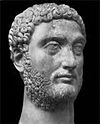
|
Imperator Caesar Marcvs Avrelivs Numerivs Nvmerianvs Avgvstvs (died 284) |
Son of Carus, succeeded him jointly with his brother Carinus. Circumstances of his death are unclear; he was possibly assassinated. | Late July/early August 283 | 284(?) | 1 year | ||
Notes
[edit]- ^ This numbering of the emperors is not official.
- ^ Roman victory titles are not included in this listing unless invariably part of the emperor's regnal name.
- ^ Unless noted, all dates are in AD.
- ^ Also referred to on coins as:
- C(aius) Caesar Divi Avg(vstvs)[17]
- ^ Vitellius did not enter Rome until June or July 69.[30]
- ^ Vespasian was proclaimed emperor by his soldiers on 1 July 69, but was not proclaimed as such by the Senate until 21 December of that year.[33]
- ^ Italics indicate a continuation of reign.
- ^ The other claimants for the throne in the Year of the Five Emperors were Pescennius Niger and Clodius Albinus, supported by the Syrian and British legions respectively. Severus defeated Niger in 194, and Albinus in 197.[53]
- ^ Severus was proclaimed emperor by his troops on 13 April 193 and by the Senate in July of that year.[53]
- ^ a b c d Some historians date the reigns of emperors who reigned in 238 to roughly two months after the dates given in the table. So according to these historians, Gordian I and II reigned from 22 March to 12 April 238, Maximinus Thrax was assassinated on 24 June that year, Pupienus and Balbinus reigned from 22 April to 29 July of that year, and Gordian III was proclaimed emperor upon the assassinations of Pupienus and Balbinus on 29 July 238.[72]
- ^ The birth date of Balbinus is uncertain. According to Zonaras, he took the throne at the age of 60; this age gives Balbinus a birth date of 178.[76]
References
[edit]- ^ Rubicon. Holland, T. Abacus, 978-0349115634
- ^ Chester G. Starr, A History of the Ancient World, Second Edition. Oxford University Press, 1974. pp. 670–678.
- ^ Herrin, Judith (2011-03-12). "The Glories of Byzantium". Wall Street Journal. ISSN 0099-9660. Retrieved 2017-12-10.
- ^ Asimov, [title?], p. 198.
- ^ Lee, pp. 163–164.
- ^ Goldsworthy, pp. 425–440
- ^ Breeze & Dobson, pp. 251–255
- ^ Moss, pp. 24–28, 281–284.
- ^ CoinArchives Augustus 2013.
- ^ HISTORY.com 2009.
- ^ Grant 1998.
- ^ Eck 2003, p. 9, 45, 50.
- ^ Wildwinds Tiberius.
- ^ Pohl 1998.
- ^ Suetonius, Tiberius Nero Caesar, paragraph LXXIII.
- ^ Levick 1999, pp. 68–81.
- ^ a b Wildwinds Caligula.
- ^ The Editors of Encyclopaedia Britannica 1998a.
- ^ Suetonius, Caius Caesar Caligula, paragraphs I, VII, LVIII.
- ^ Wildwinds Claudius.
- ^ Project Gutenberg Claudius.
- ^ Suetonius, Tiberius Claudius Drusus Caesar, paragraphs I–III, X.
- ^ Cavendish 2004.
- ^ The Editors of Encyclopaedia Britannica & 1998 Julia Agrippina.
- ^ The Editors of Encyclopaedia Britannica 1999.
- ^ OCRE Galba.
- ^ Badian 1998a.
- ^ OCRE Otho.
- ^ Lendering, Otho 2006.
- ^ a b Donahue 1999.
- ^ Wildwinds Vitellius.
- ^ Badian 1998b.
- ^ a b c d Chilver 1998b.
- ^ CNG Vespasian.
- ^ Wildwinds Titus.
- ^ a b Chilver 1998a.
- ^ CNG Domitian.
- ^ Jones 1992, p. 22.
- ^ Lendering, Nerva 2006.
- ^ Lendering, Trajan 2006.
- ^ Forum Ancient Coins Hadrian.
- ^ Lendering, Hadrian 2006.
- ^ Wildwinds Antoninus Pius.
- ^ Lendering, Antoninus Pius 2006.
- ^ Lendering, Lucius Verus.
- ^ a b Lendering, Marcus Aurelius 2006.
- ^ Wildwinds Commodus.
- ^ Meijer 2004, p. 63, 65.
- ^ Wildwinds Pertinax.
- ^ Library of Congress 1993.
- ^ a b The Editors of Encyclopaedia Britannica & 1998 Didius Julianus.
- ^ Wildwinds Didius Julianus.
- ^ a b c d The Editors of Enyclopaedia Britannica & 1998 Septimius Severus.
- ^ Wildwinds Septimius Severus.
- ^ Birley 1999, pp. 1, 187.
- ^ CNN Almanac Feb 4.
- ^ Wildwinds Caracalla Aurelius.
- ^ Kolb 1998.
- ^ Wildwinds Geta Augustus.
- ^ The Editors of Enyclopaedia Britannica & 1998 Geta.
- ^ Wildwinds Macrinus.
- ^ Lendering, Macrinus 2005.
- ^ Portable Antiquities Scheme Diadumenian.
- ^ Ocre Elagabalus.
- ^ The Editors of Encyclopaedia Britannica & 1998 Elagabalus.
- ^ The Editors of Encyclopaedia Britannica & 1998 Julia Maesa.
- ^ Wildwinds Severus Alexander.
- ^ The Editors of Encyclopaedia Britannica & 1998 Severus Alexander.
- ^ Forum Ancient Coins Severus Alexander.
- ^ Augustus Coins Maximinus Thrax.
- ^ Encyclopaedia Britannica & 1998, Maximinus.
- ^ McMahon 1998.
- ^ Lendering, Gordian I and II 1998.
- ^ Encyclopaedia Britannica & 1998, Gordian I.
- ^ a b Lendering, Pupienus 2006.
- ^ a b Lendering, Balbinus 2005.
- ^ Wildwinds, Balbinus.
- ^ Lendering, Gordian III 2006.
- ^ Meckler 2001.
- ^ Wildwinds Philip I.
- ^ Lendering, Philip the Arab 2006.
- ^ Wildwinds Philip II.
- ^ Forum Ancient Coins Philip II.
- ^ Wildwinds Decius.
- ^ The Editors of Enyclopaedia Britannica & 1998, Decius.
- ^ Adkins & Adkins 1998, p. 28.
- ^ Chrystal 2015, p. 193.
- ^ Willdwinds Herennius Etruscus.
- ^ Bunson 2014, p. 297.
- ^ Lendering, Hostilian 2006.
Sources
[edit]- Adkins, Lesley; Adkins, Roy A. (1998). Handbook to Life in Ancient Rome. New York: Oxford University Press. ISBN 978-0195123326.
- "Antoninus Pius, Roman Imperial Coins". Wildwinds. Retrieved 6 January 2019.
- "Augustus - Ancient History - HISTORY.com". HISTORY.com. 9 November 2009. Retrieved 25 December 2018.
- Badian, E. (20 July 1998). "Galba". Encyclopaedia Britannica. Retrieved 27 December 2018.
- Badian, E. (20 July 1998). "Aulus Vitellius". Encyclopaedia Britannica. Retrieved 27 December 2018.
- "Balbinus, Roman Imperial Coins". Wildwinds. Retrieved 13 January 2019.
- Birley, Anthony R. (1999) [1971]. Septimius Severus: The African Emperor. London: Routledge. ISBN 978-0415165914.
{{cite book}}: CS1 maint: ref duplicates default (link) - "Books about Claudius, Emperor of Rome, 10 B.C.-54 A.D. -- Humor". Project Gutenberg.
- Bunson, Matthew (2014). Encyclopedia of the Roman Empire. New York: Facts On File. ISBN 9781438110271.
- "Caligula, Roman Imperial Coins". Wildwinds. Retrieved 26 December 2018.
- Cavendish, Richard (10 October 2004). "Death of the Emperor Claudius". Vol. 54, no. 10. History Today. Retrieved 26 December 2018.
{{cite magazine}}: Cite magazine requires|magazine=(help)CS1 maint: date and year (link) - "Caracalla Denarius, RIC 231, RSC 632, BMC 105". Wildwinds. Retrieved 1 January 2019.
- "Caracalla Silver Denarius - Mars". Wildwinds. Retrieved 1 January 2019.
- "CNN - Almanac - February 4, 1998". CNN. Retrieved 5 January 2019.
- Chilver, Guy Edward Farquhar (20 July 1998). "Domitian". Encyclopaedia Britannica. Retrieved 27 December 2018.
- Chilver, Guy Edward Farquhar (20 July 1998). "Vespasian". Encyclopaedia Britannica. Retrieved 27 December 2018.
- Chrystal, Paul (2015). Roman Military Disasters: Dark Days & Lost Legions. Pen and Sword. ISBN 978-1473873964.
- "Claudius, Roman Imperial Coins". Wildwinds. Retrieved 26 December 2018.
- "Commodus, Roman Imperial Coins". Wildwinds. Retrieved 29 December 2018.
- "Davissons, Ltd. > E-Auction 3, Lot Number 26". CoinArchives. 7 December 2013. Retrieved 26 December 2018.
- "Trajan Decius, Roman Imperial Coins of". Wildwinds. Retrieved 17 January 2019.
- "Diadumenian". Portable Antiquities Scheme. Retrieved 1 January 2019.
- "Didius Julianus, Roman Imperial Coins". Wildwinds. Retrieved 6 January 2019.
- "Domitian". CNG. Retrieved 27 December 2018.
- Donahue, John F. (1999). "Roman Emperors DIR Vitellius". De Imperatoribus Romanis. Retrieved 27 December 2018.
- Eck, Werner (2003). The Age of Augustus. Translated by Schneider, Deborah Lucas (new material by Sarolta A. Takács). Oxford: Blackwell Publishing. ISBN 978-0631229575 (hardcover); ISBN 978-0631229582 (paperback).
- "Geta, AR denarius, 19mm, 210 AD". Wildwinds. July 2011. Retrieved 1 January 2019.
- Grant, Michael (20 July 1998). "Augustus". Retrieved 26 December 2018.
{{cite web}}: CS1 maint: ref duplicates default (link) - "Herennius Etruscus, AR Antoninianus, 251 AD". Wildwinds. Retrieved 20 January 2019.
- Jones, Brian W. (1992). The Emperor Domitian. London: Routledge. ISBN 9780415101950.
- Kolb, Frank P. (20 July 1998). "Caracalla". Encyclopaedia Britannica. Retrieved 1 January 2019.
{{cite web}}: CS1 maint: ref duplicates default (link) - Lendering, Jona (2006). "Antoninus Pius". Livius.org. Retrieved 29 December 2018.
- Lendering, Jona (2006). "Balbinus". Livius.org. Retrieved 13 January 2019.
- Lendering, Jona (2006). "Decimus Clodius Albinus". Livius.org. Retrieved 1 January 2019.
- Lendering, Jona (2006). "Gordian I and II". Livius.org. Retrieved 10 January 2019.
- Lendering, Jona (2006). "Gordian III". Livius.org. Retrieved 14 January 2019.
- Lendering, Jona (2006). "Hadrian". Livius.org. Retrieved 30 December 2018.
- Lendering, Jona (2006). "Hostilian". Livius.org. Retrieved 27 January 2019.
- Lendering, Jona (2004). "Lucius Pescennius Niger". Livius.org. Retrieved 1 January 2019.
- Lendering, Jona (2006). "Lucius Verus". Livius.org. Retrieved 29 December 2018.
- Lendering, Jona (2005). "Macrinus". Livius.org. Retrieved 1 January 2019.
- Lendering, Jona (2006). "Marcus Aurelius". Livius.org. Retrieved 29 December 2018.
- Lendering, Jona (2006). "Nerva". Livius.org. Retrieved 30 December 2018.
- Lendering, Jona (2006). "Otho". Livius.org. Retrieved 27 December 2018.
- Lendering, Jona (2005). "Pertinax". Livius.org. Retrieved 13 January 2019.
- Lendering, Jona (2006). "Philip the Arab". Livius.org. Retrieved 17 January 2019.
- Lendering, Jona (2006). "Trajan". Livius.org. Retrieved 30 December 2018.
- Levick, Barbara (1999). Tiberius the Politician. Routledge. ISBN 0415217539.
- "Macrinus Aureus, RIC 25, Cohen 46, BMC 44note". Wildwinds. Retrieved 1 January 2019.
- "Maximinus Thrax denarii". Augustus Coins. Retrieved 10 January 2019.
- McMahon, Robin (2001). "Pupienus (238 A.D.) and Balbinus (238 A.D.)". De Imperatoris Romanis. Retrieved 15 January 2019.
- Meckler, Michael L. (2001). "Gordian III (238-244 A.D.)". De Imperatoris Romanis. Retrieved 15 January 2019.
- Meijer, Fik (2004). Emperors Don't Die in Bed. Psychology Press. ISBN 9780415312011.
- Moss, Henry (1980) [1935]. The Birth of the Middle Ages. London: Greenwood Press. ISBN 978-0313227080.
- "Pertinax, Publius Helvius, Emperor of Rome, 126-193". Library of Congress. 24 September 1993. Retrieved 6 January 2019.
- "Pertinax, Roman Imperial Coins of". Wildwinds. Retrieved 6 January 2019.
- "Philip I, Roman Imperial Coins of". Wildwinds. Retrieved 16 January 2019.
- "Philip II, Roman Imperial Coins of". Wildwinds. Retrieved 16 January 2019.
- Pohl, Frederik (20 July 1998). "Tiberius". Retrieved 26 December 2018.
{{cite web}}: CS1 maint: ref duplicates default (link) - "Elagabalus". OCRE. Retrieved 4 January 2019.
- "RIC I (second edition) Galba 227". OCRE. Retrieved 27 December 2018.
- "Otho". OCRE. Retrieved 27 December 2018.
- "Roman Coins of Hadrian". Forum Ancient Coins. Retrieved 29 December 2018.
- "Roman Coins of Philip II". Forum Ancient Coins. Retrieved 17 January 2019.
- "Sear Roman Coins and their Values (RCV 2000 Edition) Number 1762". Wildwinds. Retrieved 26 December 2018.
- "Sear Roman Coins and their Values (RCV 2000 Edition) Number 2200". Wildwinds. Retrieved 27 December 2018.
- "Sear Roman Coins and their Values (RCV 2000 Edition) Number 2514". Wildwinds. Retrieved 27 December 2018.
- "Sear Roman Coins and their Values (RCV 2000 Edition) Number 6831". Wildwinds. Retrieved 1 January 2019.
- "Sear Roman Coins and their Values (RCV 2000 Edition) Number 6887". Wildwinds. Retrieved 1 January 2019.
- "Sear Roman Coins and their Values (RCV 2000 Edition) Number 7249". Wildwinds. Retrieved 1 January 2019.
- "Septimius Severus. 193-211 AD. AR Denarius (3.49 gm). Struck 193 AD". Wildwinds. Retrieved 4 January 2019.
- "Severus Alexander". Forum Ancient Coins. Retrieved 8 January 2019.
- "Severus Alexander, AV Aureus. AD 222". Wildwinds. Retrieved 4 January 2019.
- Tranquillus, C. Suetonius. Forester, T. (ed.). The Lives of the Twelve Caesars. Translated by Thomson, Alexander.
- The Editors of Encyclopaedia Britannica (20 July 1998). "Caligula". Encyclopaedia Britannica. Retrieved 26 December 2018.
{{cite web}}:|last=has generic name (help) - The Editors of Encyclopaedia Britannica (20 July 1998). "Decius". Encyclopaedia Britannica. Retrieved 17 January 2019.
{{cite web}}:|last=has generic name (help) - The Editors of Encyclopaedia Britannica (20 July 1998). "Elagabalus". Encyclopaedia Britannica. Retrieved 6 January 2019.
{{cite web}}:|last=has generic name (help) - The Editors of Encyclopaedia Britannica (20 July 1998). "Gordian I". Encyclopaedia Britannica. Retrieved 10 January 2019.
{{cite web}}:|last=has generic name (help) - The Editors of Encyclopaedia Britannica (20 July 1998). "Marcus Didius Severus Julianus". Encyclopaedia Britannica. Retrieved 6 January 2019.
{{cite web}}:|last=has generic name (help) - The Editors of Encyclopaedia Britannica (20 July 1998). "Publius Septimius Geta". Encyclopaedia Britannica. Retrieved 1 January 2019.
{{cite web}}:|last=has generic name (help) - The Editors of Encyclopaedia Britannica (20 July 1998). "Julia Agrippina". Encyclopaedia Britannica. Retrieved 26 December 2018.
{{cite web}}:|last=has generic name (help) - The Editors of Encyclopaedia Britannica (20 July 1998). "Julia Maesa". Encyclopaedia Britannica. Retrieved 6 January 2019.
{{cite web}}:|last=has generic name (help) - The Editors of Encyclopaedia Britannica (20 July 1998). "Maximinus". Encyclopaedia Britannica. Retrieved 10 January 2019.
{{cite web}}:|last=has generic name (help) - The Editors of Encyclopaedia Britannica (20 July 1998). "Septimius Severus". Encyclopaedia Britannica. Retrieved 5 January 2019.
{{cite web}}:|last=has generic name (help) - The Editors of Encyclopaedia Britannica (20 July 1998). "Severus Alexander". Encyclopaedia Britannica. Retrieved 6 January 2019.
{{cite web}}:|last=has generic name (help) - The Editors of Encyclopaedia Britannica (27 May 1999). "Nero". Encyclopaedia Britannica. Retrieved 26 December 2018.
{{cite web}}:|last=has generic name (help)CS1 maint: ref duplicates default (link) - "Vespasian, with Titus and Domitian as Caesares". CNG. Retrieved 27 December 2018.
